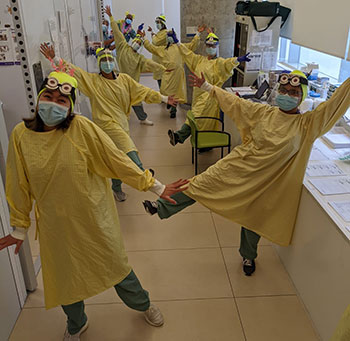COVID-19 Assessment Centre at St. Michael’s has adapted to ethically test children

By Maria Sarrouh

On Halloween, children walking into St. Michael’s COVID-19 assessment centre found the staff’s yellow medical gowns decorated to look like Minions costumes, an effort by staff to make the testing space more welcoming. Enlarge photo
Stickers, comfort positions and consent; these are just a few of the ways the St. Michael’s Assessment Centre has adapted its COVID-19 testing protocols for children.
A COVID-19 test can intimidate anyone. But walking into a hospital full of people wearing yellow gowns, face shields and gloves can be particularly scary for kids.
“It’s important that the experience isn’t traumatizing,” said Sarah Mattok, a Care and Transitions Facilitator at St. Michael’s who worked with the assessment centre to adapt it to young people. “The child might have to go through the test again, so we don’t want them to remember it as something terrible. We want to do everything we can to make it more comfortable.”
Staff have worked to make the space more welcoming to children since mid-August, when the St. Michael’s Assessment Centre began seeing more young people as schools prepared to re-open.
Staff decorated the walls of testing booths with stickers of alphabets, animals, planes and trains – a way to establish rapport with children and help distract them from the difficulty of the test.
On Halloween, children walking into St. Michael’s COVID-19 assessment centre found the staff’s yellow medical gowns decorated to look like Minions costumes, another effort by staff to make the testing space more welcoming.
“It’s something for the children to look at and concentrate on, and helps make the space less sterile and hopefully less intimidating,” said Mattok.
Staff also worked with the Centre for Clinical Ethics (CCE), realizing that families could face challenges, including daycare costs and missed work, if their children were too afraid to be tested.
“We tried to put in place all the mechanisms we could so testing would be less intimidating, and families wouldn’t be put in a more difficult position,” said Dr. Jamie Robertson, a Clinical Ethicist at the CCE who serves Unity Health Toronto.
For toddlers or school age children, parents are now asked to hold their children in their lap or sit directly next to them, helping to hold their arms gently out of the way. This is an example of “comfort positioning”, a technique that can prevent injury during the procedure.
“It’s not a comfortable test. Even when I had it done, I wanted to yank the nurse’s hand away,” said Dr. Robertson. “To expect a five-year-old to go through it without some extra help and physical support is asking a lot.”
Parents who indicate their child is coming for testing also receive a resource document with tips on how to talk to their children about the test, and explanatory videos from the B.C. Children’s Hospital and SickKids. There’s also a link to a “social story”, a form of sharing information with children with autism spectrum disorders by describing a situation through pictures and relevant social cues.
Mattok recommends that parents speak honestly with their children, use simple words and not mislead them about the test.
“Don’t say it’s not going to hurt. Say that staff will do their best, but it’s possible it’ll be uncomfortable, and it’ll be over quickly,” Mattok said.
But what happens if a child refuses a COVID-19 swab? This is a question staff have considered since children first began walking into the assessment centre. There is no stated age of consent for health care treatment — including tests — in Ontario. According to the Health Care Consent Act, minors that are deemed capable of understanding treatment information and reasonably foreseeable consequences are able to make their own treatment decisions.
When children are unable to do this, parents must make the decision on their behalf, taking the children’s views and best interests into account. If parents are able to engage children in an age-appropriate way to gain their cooperation, the test can be performed safely and ethically. However, Dr. Robertson explained if a child can understand the process of the nasal swab and the implications of the test, they are within their legal right to refuse it.
“If they say ‘no’, that has to be the answer,” Dr. Robertson said. “We have to respect that, even though that’s a hard thing for parents to understand.”
About St. Michael’s Hospital
St. Michael’s Hospital provides compassionate care to all who enter its doors. The hospital also provides outstanding medical education to future health care professionals in more than 27 academic disciplines. Critical care and trauma, heart disease, neurosurgery, diabetes, cancer care, care of the homeless and global health are among the Hospital’s recognized areas of expertise. Through the Keenan Research Centre and the Li Ka Shing International Healthcare Education Centre, which make up the Li Ka Shing Knowledge Institute, research and education at St. Michael’s Hospital are recognized and make an impact around the world. Founded in 1892, the hospital is fully affiliated with the University of Toronto.
About Unity Health Toronto
Unity Health Toronto, comprised of Providence Healthcare, St. Joseph’s Health Centre and St. Michael’s Hospital, works to advance the health of everyone in our urban communities and beyond. Our health network serves patients, residents and clients across the full spectrum of care, spanning primary care, secondary community care, tertiary and quaternary care services to post-acute through rehabilitation, palliative care and long-term care, while investing in world-class research and education. For more information, visit www.unityhealth.to.
